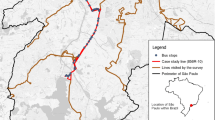Abstract
This study describes an approach for predicting travel time by kriging. The kriging method, which is a means of spatial prediction, is used as prediction measure for car travel time in an imaginary four-dimensional space. Each point in the space represents a single journey: the coordinates of a point are the coordinates of the origin and destination on a plane. The travel time can then be viewed as a function over this four-dimensional space. The prediction relies on the feature that nearby points (in the four-dimensional space) will have almost the same travel time. In this approach, it is not necessary to break down travel times from origin to destination into link travel times. The approach will also allow us to use information from “probe vehicles” for travel time prediction in the near future. The feasibility of this approach is demonstrated through a case study in London and its environs. The case study uses 200 observations for verification. The multiple correlation coefficient of estimated travel time and the verification data is 0.9045. The results indicate that 95% prediction limits are between ±10 minutes and ±30 minutes for travel between two arbitrary points. This prediction method is effective for urban districts with links having changeable travel time owing to congestion.
Similar content being viewed by others
References
AA Route Planner http://www.theaa.com/route-planner/index.jsp. Accessed 2 Feb 2009
Braxmeier H, Schmidt V, Spodarev E (2005) Kriged road-traffic maps. In: Pilz J (ed) Interfacing geostatistics, GIS and spatial data bases. Proceedings of the international conference, StatGIS 2003. Advances in spatial science. Springer, Berlin, pp 39–52
Chien SI, Kuchipudi CM (2003) Dynamic travel time prediction with real-time and historic data. J Transp Eng 129(6):608–616
Cressie N (1993) Statistics for spatial data. Revised edition. Wiley, New York, pp. 29–170
Delmelle EM, Rogerson PA, Akellad MR, Battae R, Blattf A, Wilsonf G (2005) A spatial model of received signal strength indicator values for automated collision notification technology. Transp Res Part C 13(5–6):432–447
Dia H (2001) An object-oriented neural network approach to short-term traffic forecasting. Eur J Oper Res 131(2):253–261
Du J, Aultman-Hall L (2006) Using spatial analysis to estimate link travel times on local roads. Transportation Research Board 2006 Annual Meeting CD-ROM, 06-0676
Google Maps http://maps.google.co.uk/. Accessed 2 Feb 2009
Hwang L, McCorkindale D (1994) Troll field depth conversion using geostatistically derived average velocities. Lead Edge 13(4):262–269
Inoue R, Kigoshi N, Shimizu E (2005) Applicability of spatio-temporal kriging to land price estimation. Papers and Proceedings of the Geographic Information Systems Association, vol. 14, pp. 39–42 (in Japanese)
Keepmoving (2007) Europe’s slowest cities. www.keepmoving.co.uk/driversvoice/article.php. Accessed 15 Aug 2007
Kwon J, Coifman B, Bickel P (2000) Day-to-day travel-time trends and travel-time prediction from loop-detector data. Transp Res Rec 1717:120–129
Love RF, Üster H (2001) A statistical comparison of three goodness-of-fit criteria used in modelling distances. J Appl Math Decis Sci 5(4):235–251
MultiMap http://www.multimap.com/directions/. Accessed 2 Feb 2009
Park D, Rilett LR (1998) Forecasting multiple-period freeway link travel times using modular neural networks. Trans Res Rec 1617:163–170
Rice J, van Zwet E (2004) A simple and effective method for predicting travel times on freeways. IEEE Trans Intell Transp Syst 5(3):200–207
Transport Direct website http://www.transportdirect.info/TransportDirect/en/. Accessed 15 Aug 2007
Zhang X, Rice JA (2003) Short-term travel time prediction. Transp Res C 11(3–4):187–210
Author information
Authors and Affiliations
Corresponding author
Rights and permissions
About this article
Cite this article
Miura, H. A study of travel time prediction using universal kriging. TOP 18, 257–270 (2010). https://doi.org/10.1007/s11750-009-0103-6
Received:
Accepted:
Published:
Issue Date:
DOI: https://doi.org/10.1007/s11750-009-0103-6




